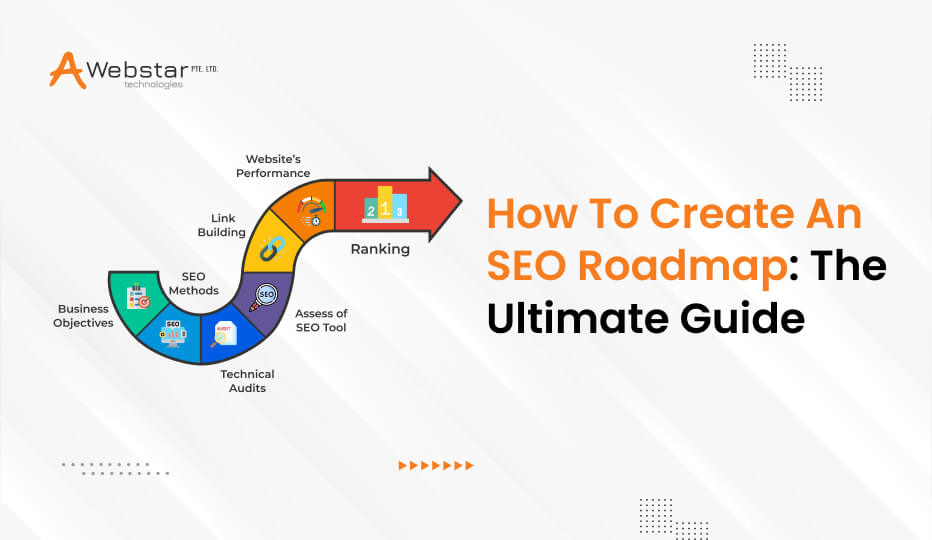
These days, every business is turning online. It creates tough competition for brands or businesses. Your brand or business needs a strong online presence to stay ahead of this competition. Here, the SEO roadmap can help your business reach its peak in today’s crowded online marketplace.
An SEO roadmap can be a paper or digital document that outlines the systematic strategy to enhance your website’s search engine performance. It may consist of tasks, timeframes, and people responsible for each task. It is made to fit your specific SEO targets. Achieving these aims should eventually assist you in reaching your general business goals. An SEO agency can provide effective tools and strategies that can help enhance your website’s visibility, attract more visitors, and grow your business.
However, where do you begin? How can you use complex SEO strategies to bring out the most of your business? These are important questions to consider. So, let’s dive into the step-by-step SEO roadmap and stand out your business among your competitors.
Difference Between SEO RoadMap and SEO Strategy
SEO Roadmap and SEO strategy are entirely two different considerations. They both involve proper planning and implementation of SEO. So, without any further ado let us clarify things and understand the critical differences between the two.
SEO RoadMap Vs SEO Strategy
SEO strategy works as a compass that shows the purpose of your SEO effort. It includes the what and why of the journey. Whereas the roadmap acts as a navigator that includes how and when. Also, the SEO strategy has a more extended timeframe while the roadmap includes specific timelines for completing tasks and achieving objectives.
SEO strategy mainly focuses on understanding the business goals and target audience. It also considers the competitive landscape and the website’s current SEO state. A roadmap focuses on implementing the SEO strategy and the specific steps required to achieve the overall objectives.
| Aspects | SEO RoadMap | SEO Strategy |
| Definition | A detailed plan that includes specific actions and tasks to reach SEO goals within a certain period. | A big plan that sets clear aims, ways, and strategies for enhancing the visibility and overall performance of a website in search engines. |
| Timeframe | Short-term (weeks to months) | Long-term (Months to years) |
| Focus | Specific actions and daily tasks | Big-picture planning and overall direction |
| Components | Includes tasks such as Keyword Research, on-page optimisation, technical fixes, content creation etc. | Covers market analysis, competitor research, target audience identification, goal setting and research allocation |
| Implementation | Provides a step-by-step guide for executing specific SEO activities within a defined timeframe | Guides decision-making and resource allocation to align with the overarching SEO goals and objectives |
| Flexibility | Typically less flexible due to the specific tasks and timelines outlined. | Allows for adaptation and adjustment based on evolving trends, market conditions, and performance metrics. |
| Deliverables | Concrete tasks, timelines and benchmarks | Overall direction, priorities and resource allocation guidelines |
| Measurement | Success is measured by the completion of tasks and achievement of short-term goals | Success is assessed by the effect on primary performance indicators (KPIs), like growth in organic traffic, position of keywords, rates of conversion and so on. |
| Role | Guides the day-to-day activities of the SEO team or individual practitioners. | Shows the general path and choices within the SEO program, usually headed by upper-level management or SEO professionals. |
Step-by-Step Guide to Creating SEO Roadmap for Business Goals
A valuable asset for your business is the development of the roadmap of an SEO. It heavily demands ongoing commitment, detailed planning and collective teamwork. The following section of the blog post will explore the advantages of a roadmap for your business. Let us have a look at them together below!!
Consider your Business Objectives
While creating an SEO roadmap strategy you must consider your business objectives. It involves a detailed analysis of the aim you want to achieve as a company. It may include increasing sales, expanding your customers, enhancing brand visibility or improving market authority.
Also, it is recommended to keep your objectives at the forefront. Then, conduct regular check-ins to ensure that you are progressing on the right track. For instance, if your goal is to enhance brand visibility, your roadmap must prioritise creating and optimising blog content. It must showcase the industry’s expertise.
Select Appropriate SEO Methods
You must start by conducting detailed keyword research to understand your target audience’s search behaviour. It is recommended to conduct keyword research using tools like SEMrush to identify high-value keywords. The next step is to optimise your website’s on-page elements. These include titles, meta descriptions, headers and content to include these keywords naturally.
You must enhance user experience and site performance by improving page load speed, mobile responsiveness and navigation. Regularly monitor your SEO efforts to track key metrics. Thus, you must adjust your strategy accordingly for continuous improvement.
Technical Audits
Technical audits are very important to make sure your website has good structure and technical wellness. By doing deep crawling and analysis of a site, you can discover and fix different technical problems that may affect its search engine performance.
These examinations usually involve checking things like broken links, repeated content, crawl errors or mobile optimization to guarantee the ease of access and indexability by search engines for your website. You can utilise tools like Screaming Frog SEO Spider to check for crawl errors and broken links. Furthermore, you must ensure your XML sitemap is properly submitted to Google Search Console. Fixing these technical problems could make the user experience better, improve visibility in search engines and create a strong base for good SEO work.
Assess the Tools and Resources Required
Selection of the right SEO platforms and tools is important to the success of your plan. It will help you lay down a strong foundation to align your strategy. Thus, you can achieve all your marketing goals.
Google Keyword Planner proves to be a game changer. It helps you find high-valued keywords based on your business and campaign needs. In the same way, tools for SEO content optimisation like Ahrefs and SEMrush conduct on-page and off-page SEO activities. They help in delivering much better results.
Link Building
Link building in SEO means getting hyperlinks from other websites to yours. These links work as votes of confidence that tell search engines your site is trustworthy and has authority. Good strategies for link building involve making excellent content others like to link with, doing guest blogging or forming relationships with reliable sites. Boosting your link profile is beneficial for your website as it can improve rankings in search engines, bring more organic visitors and enhance your online presence.
For example, you create a blog post about a specific subject, which is of high quality. Then, approach websites that have the authority to link back to this content as an important reference. This will improve your site’s trustworthiness and its ranking in the search engine results pages.
Consistently Monitor your Website’s Performance
You must regularly assess your website’s performance to check its effectiveness. You must make sure that you are achieving the desired results. The consistent checking of your website performance data empowers you to dig deep into the performance of various content types.
It is essential to check the way users interact with them. This guides you toward refining your content strategy with a focus on crafting content that aligns with your target audience. Maintain a track of work updates and results. It is beneficial to use Google Analytics to track changes in traffic and user behaviour. Also, you must adjust the roadmap as necessary to address any issues or capitalise on successful strategies.
Conclusion
In a nutshell, the above blog post examines the main parts of the search engine optimisation roadmap. After reading this write-up, you will understand how to improve your website’s rank in search results and enhance organic visitor numbers. Consequently, you will encourage more conversions. It is crucial to keep a check on off-page and on-page optimisation.
Along with that, check analytics to fine-tune your strategies by monitoring and modifying them frequently. Take into consideration more resources and industry events as you progress in your SEO roadmap journey. For any professional help, Awebstar Technologies is always at your service to guide you in achieving your SEO objectives.
Contact us online or call +65 6909 9163 to speak with our SEO expert to learn more about our SEO services!















































